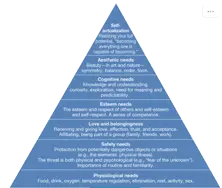When I first encountered Maslow’s hierarchy of needs, its elegant simplicity and intuitive structure immediately resonated with me. Like many others, I accepted the model as a near-universal map of human motivation: we begin by fulfilling our physiological and safety needs, then seek love and belonging, and only later develop self-esteem and pursue self-actualisation.
But over time—particularly through therapeutic work, emotional inquiry, and personal growth—I began to question this sequence. What if Maslow got part of it backwards?
From my own healing journey and through supporting others, I’ve come to believe that esteem, particularly self-love and self-acceptance, should precede love and belonging. We cannot truly give or receive love unless we first know our own worth. Without self-acceptance, relationships often become a search for validation or a way to escape ourselves—rather than a space for connection, trust, and growth.
This isn’t just personal opinion. It reflects a growing body of psychological research on self-concept, attachment, and emotional wellbeing. More significantly for me, it echoes the work of John Bradshaw, whose book Creating Love argues that authentic love requires a healed inner self. Bradshaw writes:
“Until we can affirm our own intrinsic worth, we will continue to use others to fill the hole inside of us, calling it love” (Bradshaw, 1992, p. 91).
In this article, I revisit Maslow’s hierarchy through this lens—drawing from contemporary psychology, attachment theory, and my own critical reflections. I suggest that the path to belonging is built upon a foundation of emotional integrity: the capacity to esteem ourselves not conditionally, but fully. Only then can we participate in love as a reciprocal, life-enhancing force—not as a compensatory one.
Section 1: Maslow’s Original Hierarchy
Abraham Maslow’s hierarchy of needs (1943) remains one of the most cited models in psychology. It suggests that human motivation proceeds in stages: starting with basic physiological and safety needs, then advancing to love and belongingness, esteem, and finally self-actualisation. In Maslow’s view, belonging precedes esteem—meaning we must first form relationships before developing self-respect and confidence.
While elegant, this model was shaped by the humanistic optimism of its time and lacks empirical robustness. More recent theories suggest that psychological development, particularly in the context of early attachment and trauma, challenges the universality of this sequence.
Section 2: Why Esteem, Self-Love, and Acceptance Come First
From a developmental lens, much of our emotional blueprint is formed in the first few years of life—particularly the first seven, as highlighted in Lipton’s (The Biology of Belief, 2015) epigenetic work. These early imprints determine how we perceive ourselves and others. If these formative years are marked by conditional love or emotional neglect, we often internalise the belief that we are unworthy, unlovable, or incomplete.
“The subconscious mind, which governs most of our behaviours, is formed primarily before age seven. If we don’t rewrite these programs, we live out someone else’s beliefs” (Lipton, 2015, p. 106).
Healing this conditioning requires radical self-acceptance—a shift from external validation to internal grounding. This is where esteem needs expand into emotional integrity, which includes:
Self-love: Not narcissism, but a compassionate recognition of one’s own humanity.
Self-acceptance: Embracing all parts of oneself, including wounds and imperfections.
Emotional regulation: Developing the capacity to sit with difficult emotions without projecting or suppressing them.
This inner work must come before healthy connection. Otherwise, we approach relationships from a place of deficit rather than wholeness.
Section 3: Relationships as Projections of Unhealed Wounds
Many romantic relationships begin not from a conscious choice to love, but from the neurochemical intensity of being in love. As I’ve previously explored (Tedone, 2025), the experience of “being in love” often stems from unconscious biological drives and unresolved childhood wounds, whereas the act of truly loving someone emerges from emotional maturity, self-awareness, and conscious choice.
Bradshaw (1992) similarly argues that many of us fall for partners who reflect our unmet parental dynamics:
“We fall in love with a person who carries the unresolved emotional energy of our parents” (p. 103).
When emotional regulation and self-awareness are absent, people often enter relationships to compensate for a lack of internal esteem or to heal vicariously through the other. This process is rarely conscious—yet it often results in disappointment, control dynamics, or a cycle of emotional overdependence.
Section 4: Conscious Love and Emotional Intimacy
True love, in contrast, arises when both partners are self-aware, emotionally grounded, and willing to take responsibility for their own wounds. These relationships don’t complete us—they support us in completing ourselves.
They allow for:
Vulnerability without fear of abandonment
Support without enmeshment
Boundaries without shame
As I’ve come to understand, healthy relationships are built not from neediness, but from two whole people choosing to walk together. This is where emotional intimacy—not just emotional merging—becomes possible.
Conclusion: Rewriting the Pyramid
If we reorder Maslow’s hierarchy to reflect these insights, it might look like this:
Physiological needs
Safety needs
Self-esteem, self-love, self-acceptance
Love and belongingness
Cognitive needs
Aesthetic needs
Self-actualisation
This is not merely a structural shift. It’s a call to inner work—to prioritise healing, integration, and emotional literacy as foundations for connection. We cannot truly love another until we have learned to be at peace with ourselves.
References
Bradshaw, J. (1992). Creating love: The next great stage of growth. Bantam Books.
Goleman, D. (1996). Emotional intelligence: Why it can matter more than IQ. Bloomsbury.
Lipton, B. H. (2015). The biology of belief: Unleashing the power of consciousness, matter & miracles (10th anniversary ed.). Hay House.
Tedone, M. (2025). The missing love language: Emotional integrity & efficacy. Heal with Marco. https://healwithmarco.com/the-missing-love-language-emotional-integrity-efficacy/
